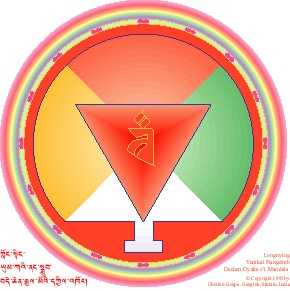Yumka Dechen Gyalmo: Difference between revisions
| Line 44: | Line 44: | ||
*[[Dzogchen Rinpoche]], [[Kirchheim]], Germany, December 1998 | *[[Dzogchen Rinpoche]], [[Kirchheim]], Germany, December 1998 | ||
*Kyabjé [[Trulshik Rinpoche]], [[Lerab Ling]], Saturday 13th November 1999 | *Kyabjé [[Trulshik Rinpoche]], [[Lerab Ling]], Saturday 13th November 1999 | ||
*[[Tulku Pegyal Rinpoche]], [[Dzogchen Beara]], December, 1999 | *[[Tulku Pegyal Rinpoche]], [[Dzogchen Beara]], 16th December, 1999 | ||
*[[Garje Khamtrul Rinpoche]], [[Dzogchen Beara]], October 2000 | *[[Garje Khamtrul Rinpoche]], [[Dzogchen Beara]], October 2000 | ||
*Kyabjé [[Trulshik Rinpoche]], [[Lerab Ling]], Sunday June 29th 2003 | *Kyabjé [[Trulshik Rinpoche]], [[Lerab Ling]], Sunday June 29th 2003 | ||
Revision as of 08:20, 12 November 2007
Yumka Dechen Gyalmo (Wyl. yum ka bde chen rgyal mo) - the peaceful dakini practice from the Longchen Nyingtik, the terma revelation of Jikmé Lingpa.
Tulku Thondup explains [1], Yumka Dechen Gyalmo is a sadhana practice on Yeshe Tsogyal, the consort of Guru Rinpoche, as a wisdom dakini. It is one of the three roots practice of the Longchen Nyingtik together with Lama Rigdzin Düpa and Yidam Palchen Düpa.
In 1774 the omniscient Jikmé Lingpa visited the Tsogyal Lake. There, amid wondrous signs, he beheld the face of the Wisdom Dakini. He also received the symbolic scripts which he deciphered on order to produce the practice text.
Through this practice one understands the dakini Yeshe Tsogyal to be the embodiment of the three kayas.
- Ultimately she is Samantabhadri in the vast sphere of Dharmakaya
- Internally she is Vajravarahi in the pure land of the Sambhogakaya
- Externally she is Yeshe Tsogyal in the world of the Nirmanakaya.
Translations
- The Queen of Great Bliss of Long-Chen Nying-Thig, translated by Tulku Thondup, Gangtok, 1983 revised 1992. Can be ordered at http://mahasiddha.org/store/Texts.html
- The Queen of Great Bliss of Long-Chen Nying-Thig, translated by Karma Sonam Drolma, Kathmandu: Dzogchen Shri Singha University, 1997
- The Longchen Nyingthig Root Sadhana of the Mother Tsogyal, The Queen of Great Bliss, called The Glorious Garland of Great Bliss, translated by Karen Liljenberg, www.zangthal.co.uk, 2006

Commentaries on Yumka Dechen Gyalmo
In Tibetan
- yum ka bde chen rgyal mo'i rtsa ba’i bsnyen yig by Jikmé Lingpa, Nyingtik Tsapö vol Om pp.313-319.
- yum ka bde chen rgyal mo'i bsnyen yig yang gsal lus dkyil mngon brjodby Jikmé Lingpa, Nyingtik Tsapö vol Om pp.321-331.
- yum ka bde chen rgyal mo'i lo rgyus by Jikmé Lingpa, Nyingtik Tsapö Vol Om p.287-288.
- Yum Ka bDe Ch'en rGyal Mo'i sGrub gZhung Gi 'Grel Ba rGyud Don sNang Ba (f. 107) by Ratön Ngawang Tendzin Dorje, a disciple of Jikmé Lingpa, in 1801.
- Yum Ka bDe Ch'en rGyal Mo'i sGrub gZhung Gi Zin Bris bDe Ch'en Lam bZang gSal Ba'i sGron Me (f. 22) by Dodrupchen Jikmé Tenpé Nyima (Nyingtik Tsapö, vol. ha 5 p 415-482).
- Yum Ka bDe Ch'en rGyal Mo'i rTsa sNgags Kyi 'Grel bShad rNam mKhyen bGrod Pa'i Them sKas (f. 6) by Jikmé Tenpé Nyima.
- Yum Ka'i rTsa sGrub Kyi Ch'o Ga'i bsDus 'Grel (f. 14) by Lingtul of Wangda, Golok, a disciple of Alak Dongak Gyatso.
- Yum Ka'i Zin Bris Kha bsKong Rig 'Dzin Zhal Lung (f. 34) by Lushul Khenpo Könmé of Dodrupchen monastery, Nyingtik Tsapö vol ha (5) pp.483-550)
- Yum Ka bDe Ch'en rGyal Mo'i sGrub gZhung Gi Zin Bris rMong Pa'i Mun Sel (f 19) by Sangye Özer of Gyarong, a disciple of Khenpo Chechok.
- Yum Ka bDe Chen rGyal Mo'i rTsa Ba'i sGrub Pa bDe Ch'en dPal Phreng Gi Tshig 'Grel (f. 63) by Gonpo Tseten of Amdo.
The Empowerment of Yumka Dechen Gyalmo
The empowerment has been given many times to the Rigpa sangha, including:
- Dzogchen Rinpoche, Santa Cruz, CA, USA, December 1985
- Kyabjé Dodrupchen Rinpoche, Brunissard, France, 23rd August 1989
- Kyabjé Dilgo Khyentse Rinpoche, Prapoutel, France, 19th August 1990
- Dzogchen Rinpoche, Kirchheim, Germany, December 1998
- Kyabjé Trulshik Rinpoche, Lerab Ling, Saturday 13th November 1999
- Tulku Pegyal Rinpoche, Dzogchen Beara, 16th December, 1999
- Garje Khamtrul Rinpoche, Dzogchen Beara, October 2000
- Kyabjé Trulshik Rinpoche, Lerab Ling, Sunday June 29th 2003
- Kyabjé Trulshik Rinpoche, Kirchheim, Monday 29th December 2003
- Kyabjé Trulshik Rinpoche, Lerab Ling, Saturday 10th December 2005
Notes
- ↑ The Queen of Great Bliss of Long-Chen Nying-Thig, translated by Tulku Thondup, Gangtok, 1983 revised 1992, p.1.